Radiation Hardened Electronics Market Size and Share
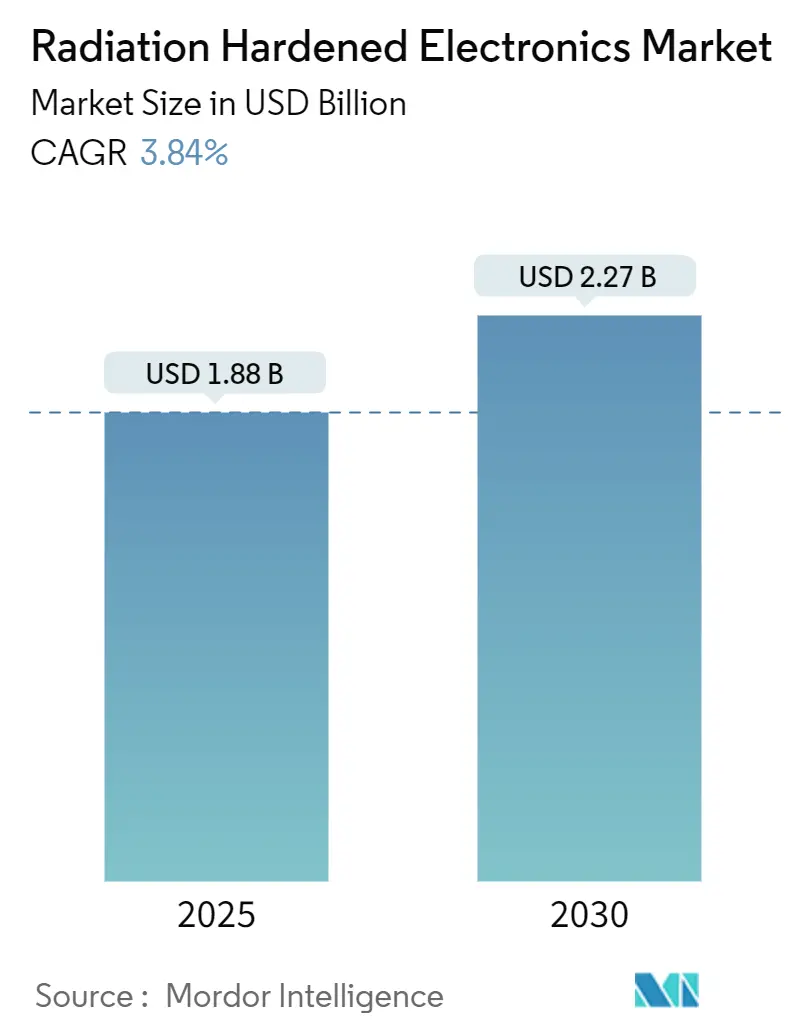
Radiation Hardened Electronics Market Analysis by Mordor Intelligence
The radiation hardened electronics market size stands at USD 1.88 billion in 2025 and is forecast to climb to USD 2.27 billion by 2030, reflecting a 3.84% CAGR. Demand continues to bifurcate between ultra-high-reliability parts for deep-space and strategic defense missions and cost-optimized, radiation-tolerant devices for proliferated low-Earth-orbit (LEO) constellations and stratospheric platforms. Geopolitical drivers-most notably NATO nuclear-modernization programs, renewed nuclear-power construction in Asia, and the ramp-up of small-satellite launches-are reshaping product road maps and qualification priorities. Commercial foundries are partnering with defense primes to stretch mature silicon nodes while integrating gallium nitride (GaN) and silicon carbide (SiC) for next-generation power systems. Supply-chain bottlenecks in ≤90 nm radiation-hard-by-process (RHBP) capacity, together with evolving export-control regimes, spur a parallel push toward radiation-hard-by-design (RHBD) methodologies that shorten development cycles and lower cost.
Key Report Takeaways
- By end-user, the space segment led with 46.3% radiation hardened electronics market share in 2024, whereas High-Altitude UAV/HAPS platforms are poised for the fastest 4.2% CAGR through 2030.
- By component, integrated circuits held 31.5% share in 2024, while field-programmable gate arrays are set to expand at a 4.6% CAGR to 2030.
- By semiconductor material, silicon maintained 71% share in 2024; gallium nitride power devices are forecast to advance at a 5.7% CAGR between 2025-2030.
- By product type, power and linear devices commanded 27.4% share of the radiation hardened electronics market size in 2024; processors and controllers are expected to grow at a 4.8% CAGR to 2030.
- By manufacturing technique, RHBP captured 55.2% share in 2024, whereas RHBD approaches are rising at a 3.9% CAGR through 2030.
- By geography, North America accounted for 39.8% share of the radiation hardened electronics market in 2024; Asia Pacific is projected to post the highest 4.1% CAGR to 2030.
Global Radiation Hardened Electronics Market Trends and Insights
Drivers Impact Analysis
| Driver | (~) % Impact on CAGR Forecast | Geographic Relevance | Impact Timeline |
|---|---|---|---|
| Surge in LEO and deep-space satellite constellations | +1.2% | Global; strongest in North America & Europe | Medium term (2-4 years) |
| Modernisation of strategic and tactical defense electronics in NATO region | +0.9% | North America, Europe | Medium term (2-4 years) |
| Nuclear-new-build momentum in Asia and Middle East | +0.7% | Asia Pacific, Middle East | Long term (≥ 4 years) |
| High-altitude UAV & supersonic aircraft electronics resilience needs | +0.5% | Global; early adoption in North America | Medium term (2-4 years) |
| Mandated radiation-tolerance standards in medical imaging | +0.4% | North America, Europe | Short term (≤ 2 years) |
| Rapid adoption of SiC/GaN rad-hard power devices in spacecraft PPU | +0.3% | Global | Short term (≤ 2 years) |
| Source: Mordor Intelligence | |||
Surge in LEO and Deep-Space Satellite Constellations
LEO mega-constellations are driving a new stratification of performance targets: 30-50 krad(Si) tolerant parts for mass-manufactured satellites versus ≥100 krad(Si) parts for geostationary and deep-space assets. Device vendors now run parallel product lines, such as miniaturized GaN power stages that blend higher integration with lower shielding mass.[1]EPC Space , "EPC Space Gas Launches First rad Hard GaN Power Stage IC," powerelectronicsworld.netSmaller spacecraft footprints intensify the need for size-, weight-, and power-optimized (SWaP) solutions while preserving single-event-effect immunity. Concurrently, on-orbit reconfigurability via radiation-tolerant FPGAs allows operators to refresh mission software without physical access, extending constellation life cycles. Strong backlog for lunar logistics and Mars relay satellites further cements deep-space demand.
Modernisation of Strategic and Tactical Defense Electronics in NATO Region
The United States and European defense ministries are channeling funds into trusted domestic microelectronics to shield critical systems from high-altitude electromagnetic pulse scenarios. The FY 2025 United States DoD budget allocates USD 24.884 million to accelerate radiation-hardened RF and opto-electronic prototypes. Test infrastructure follows suit: Naval Surface Warfare Center Crane’s Short Pulse Gamma facility underpins a USD 100 million modernization drive, enabling concurrent nuclear-modernization programs.[2]Naval Surface Warfare Center, “At-A-Glance 2025 Edition,” navsea.navy.mil
Nuclear-New-Build Momentum in Asia and Middle-East
New Gen-III+ reactors in China, India, and the Gulf states require electronics that withstand high neutron fluence for multi-decade service intervals. Oak Ridge National Laboratory highlights instrumentation amplifiers validated up to megagray TID levels, spurring sensor suppliers to co-design silicon and ceramic packages for in-core monitoring.[3]Oak Ridge National Laboratory, “Radiation-Hardened Electronics for Reactor Environments,” ornl.govLengthy qualification cycles and regulatory oversight elevate entry barriers, resulting in a tightly knit supplier base.
High-Altitude UAV and Supersonic Aircraft Electronics Resilience Needs
Stratospheric pseudo-satellite UAVs cruise at 18-25 km where radiation flux sits between aviation and low-Earth-orbit levels. Designers leverage cost-effective RHBD circuitry combined with periodic memory scrubbing to hit affordability targets while maintaining reliability. Research on integrated near-space 6G networks positions HAPS as critical relays for ubiquitous connectivity.[4]Liu, Xinhua, Zhen Gao, Ziwei Wan, Zhonghuai Wu, Tuan Li, Tianqi Mao, Xiao Liang, Dezhi Zheng, and Jun Zhang. "Toward Near-Space Communication Network in the 6G and Beyond Era." arXivRadiation-tolerant power electronics using wide-band-gap semiconductors tackle the platform’s tight energy budgets.
Restraints Impact Analysis
| Restraint | (~) % Impact on CAGR Forecast | Geographic Relevance | Impact Timeline |
|---|---|---|---|
| High design-for-reliability cost and long qualification cycles | −0.8% | Global | Long term (≥ 4 years) |
| Restricted foundry capacity for RHBP nodes ≤ 90 nm | −0.6% | Global; highest impact in North America | Medium term (2-4 years) |
| Performance trade-offs versus COTS chips | −0.4% | Global | Medium term (2-4 years) |
| ITAR / export-control supply-chain bottlenecks | −0.3% | Global; steepest for non-US manufacturers | Medium term (2-4 years) |
| Source: Mordor Intelligence | |||
High Design-for-Reliability Cost & Long Qualification Cycles
Developing radiation-hardened ASICs costs 5-10 times more than commercial equivalents. The Strategic Radiation-Hardened Electronics Council forecasts SEE test-beam oversubscription of up to 6,000 hours annually by 2025, a gap that stretches qualification queues. Space operators therefore pilot streamlined COTS-based selection processes to cut lead times, balancing life-orbit risk against launch cadence.
Restricted Foundry Capacity for RHBP Nodes ≤ 90 nm
Trusted fabs running hardened SOI or specialized twin-well processes are limited. Export-control overlays add another layer of complexity, often forcing non-U.S. system integrators to redesign around older geometries or stand in lengthy allocation lines. Programs such as SkyWater’s RH90 platform aim to relieve bottlenecks by commercializing a rad-hard SOI flow on 90 nm bulk tools.
Segment Analysis
By End-User: Space Dominance Drives Innovation Priorities
The space segment accounted for 46.3% of the radiation hardened electronics market in 2024, anchoring specification baselines for total-ionizing-dose and single-event-effect immunity. Operators moving from bespoke GEO spacecraft to proliferated LEO constellations now trade some resilience for lower cost and rapid refresh, catalyzing hybrid product lines that mate 30 krad(Si) design targets with lower shielding mass. NASA’s Artemis lunar program and commercial cislunar logistics underpin steady demand for ≥100 krad(Si) devices that survive deep-space radiation belts.
High-Altitude UAV/HAPS platforms, forecast to grow at 4.2% to 2030, extend aerospace electronics into a quasi-space radiation spectrum. Designers leverage RHBD FPGAs for adaptive payloads and use wide-band-gap power stages to meet tight energy budgets. The radiation hardened electronics market size for this sub-segment is projected to broaden as 6G network backhaul trials migrate from prototypes to operational fleets.
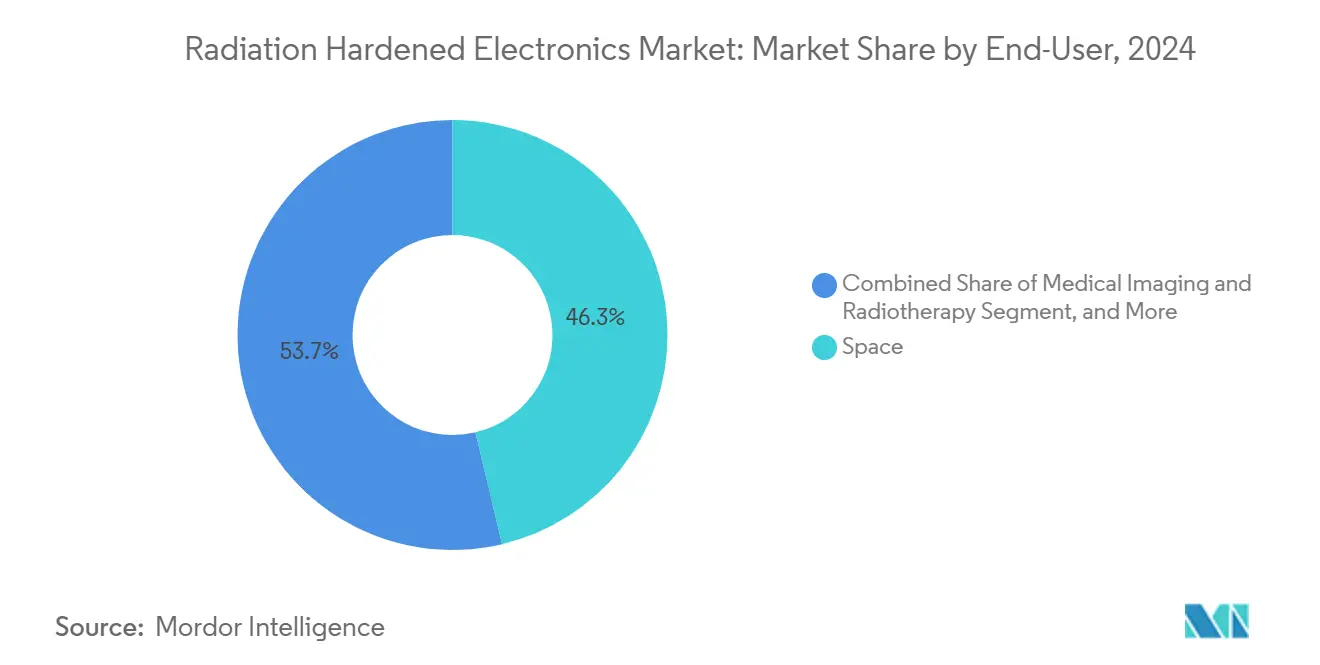
Note: Segment shares of all individual segments available upon report purchase
By Component: Integrated Circuits Lead Amid FPGA Surge
Integrated circuits held 31.5% radiation hardened electronics market share in 2024, with mixed-signal ASICs consolidating multiple analog front ends and power-management functions onto a single die to trim board-level mass. Supply risks around SEE-capable beam time are prompting chip houses to qualify identical IP blocks simultaneously on two foundry flows, bolstering continuity plans.
Field-programmable gate arrays represent the fastest 4.6% CAGR as satellite operators prize in-orbit reconfiguration. The latest Kintex UltraScale XQRKU060 class blends 2 million logic cells with on-chip scrub controllers that mitigate configuration memory upsets. The radiation hardened electronics market sees FPGAs bridging the gap between fixed-function silicon and software-only fault mitigation, carving share from discrete logic.
By Product Type: Power & Linear Dominance Challenged by Processors
Power and linear devices captured 27.4% share in 2024, driven by spacecraft power-processing units using GaN or SiC to uplift efficiency while maintaining SEL immunity. New 50 V GaN half-bridge modules rated over 2 MHz switching deliver bulk converter density gains with minimal derating under radiation.
Processors and controllers headline the fastest 4.8% CAGR as mission autonomy accelerates. EdgeCortix’s SAKURA-I AI accelerator recorded zero destructive events in heavy-ion tests, validating low-power inference engines for onboard data reduction. The radiation hardened electronics market size associated with compute-intensive payloads is set to expand as optical-sensor constellations proliferate
By Manufacturing Technique: RHBP Dominance Faces RHBD Challenge
RHBP solutions retained 55.2% share in 2024, underpinned by legacy SOI and poly-silicon isolation stacks that provide intrinsic hardness. Yet soaring mask-set costs and scarce sub-90 nm capacity encourage primes to pivot toward RHBD flows that embed triple modular redundancy and guard rings inside mainstream CMOS. Commercial Leap Ahead projects sponsor ultra-thin-body SOI wafers that promise to blend RHBP resilience with higher fmax, bending the cost curve for next-generation parts.
RHBD’s forecast 3.9% CAGR reflects its agility: designers tape out prototypes in months, use foundry shuttle runs, and rely on firmware scrubbing to catch residual faults. Software-assured architectures such as Montana State University’s RadSat show how COTS FPGAs, when triplicated and scrubbed, can meet LEO up-time metrics without unique process steps.
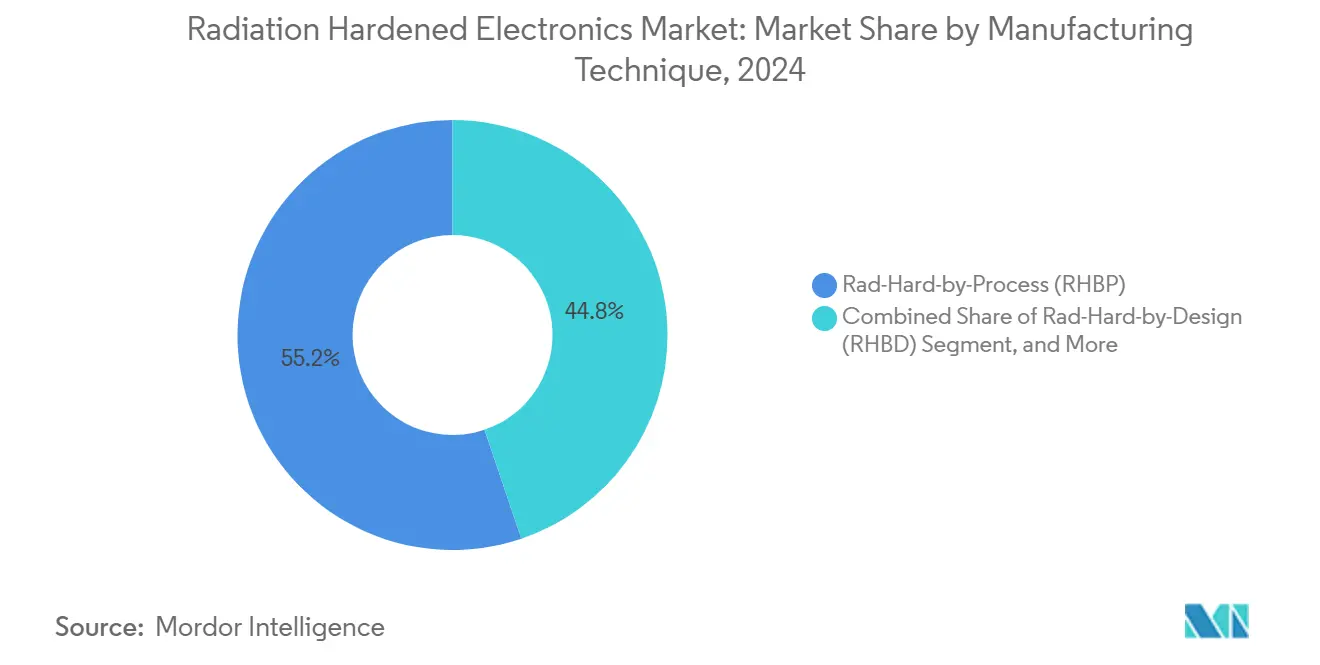
Note: Segment shares of all individual segments available upon report purchase
By Semiconductor Material: Silicon Dominance Challenged by GaN
Silicon devices continued to command 71% share in 2024 thanks to mature qualification libraries and cost-effective volume flows. Recent work on n-in-p pixel sensors and deep-trench isolation boosts TID resilience further, extending silicon’s roadmap into 2030 for mixed-signal instrumentation.
GaN, projected to grow at 5.7% CAGR, underpins next-generation power converters that run hotter and switch faster without sacrificing radiation headroom. Robust p-GaN HEMTs tested to 558 V single-event-burnout thresholds illustrate GaN’s margin over conventional devices. The radiation hardened electronics industry also experiments with SiC for high-voltage bus regulators and with InP for radiation-tolerant photonic links.
By Radiation Type: TID Devices Lead as SEE Mitigation Grows
TID-hardened devices accounted for 58.7% of 2024 revenue, reflecting mission planners’ priority to manage cumulative dose over multi-year exposures. Updated EAR language now references parts rated beyond 100 krad(Si) under ECCN 3A001, tightening classification for some commercial flows.
SEE-mitigated parts grow fastest at 5.3% CAGR as single-event-latchup in modern high-density nodes poses catastrophic risk. Design reviews now pair device-level hardening with board-level fault-isolation fusing to constrain latent damage. The radiation hardened electronics market accordingly tilts toward multi-effect qualification, merging TID, DDD, and SEE criteria in a unified test plan.
Geography Analysis
North America generated 39.8% of 2024 sales, buoyed by sustained defense budgets and NASA exploration initiatives. Trusted domestic foundries, plus dedicated beam-line capacity at facilities such as NSWC Crane, shorten certification loops and anchor many prime-contractor supply chains. Space commerce diversification into lunar communications and asteroid-prospecting missions should further support regional demand.
Asia Pacific posts the quickest 4.1% CAGR to 2030 as China, India, and South Korea scale rocket fleets and commission new-build nuclear reactors. Government space agencies co-invest with local universities in RHBD design centers to decrease reliance on imported parts. Emerging commercial launch providers likewise adopt radiation-tolerant FPGAs to meet agile-satellite business models.
Europe combines ESA’s large mission pipeline with strong nuclear-plant refurbishment schedules. Neuromorphic on-board processing programs such as the NEUROSPACE initiative underscore the region’s pivot toward ultra-low-power compute. Middle-East space offices in the UAE and Saudi Arabia pursue Mars probes and Earth-observation clusters, opening niche opportunities for localized assembly and test. South America remains nascent but benefits from Brazilian and Argentine small-satellite projects seeking home-grown avionics.
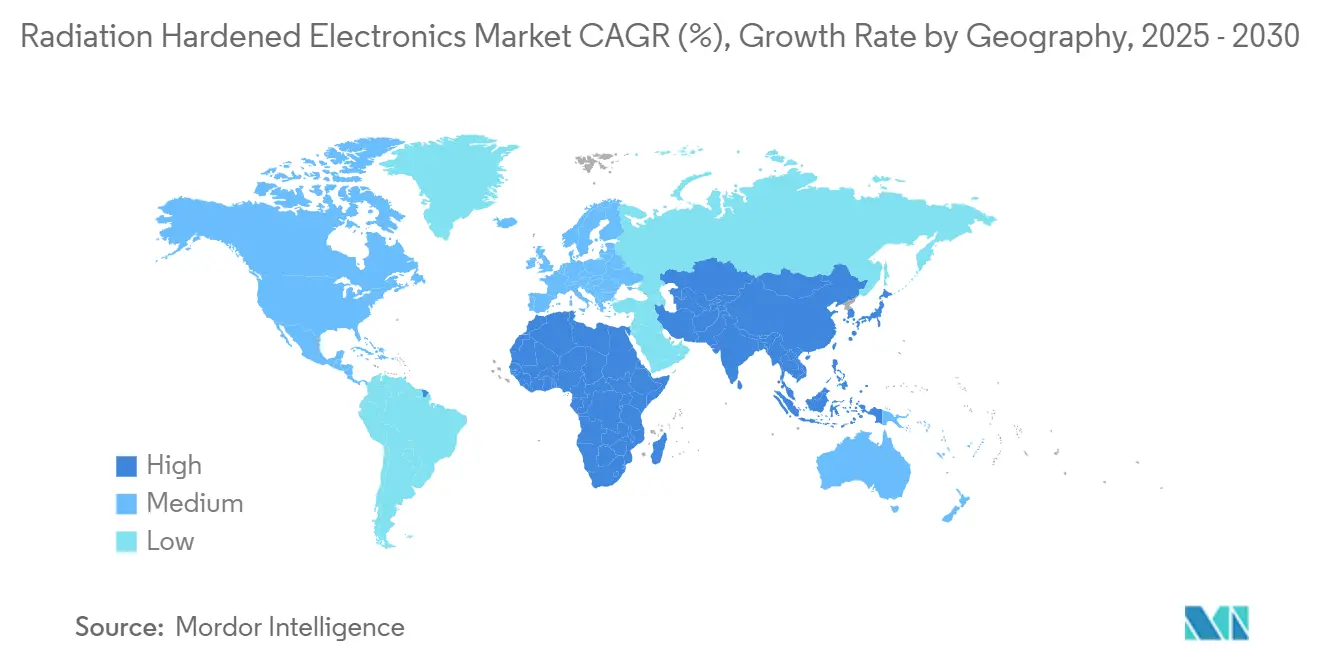
Competitive Landscape
The radiation hardened electronics market concentrates around a core of long-established defense primes, satellite subsystem makers, and specialized semiconductor houses. Incumbents leverage vertically integrated design-foundry-test chains to deliver full custom ASICs, while new entrants attack selected niches with radiation-tolerant COTS derivatives priced 30-50% lower. This cost-performance split fosters dual-sourcing strategies across most satellite constellations.
Intellectual-property portfolios increasingly emphasize error-correcting DSP cores, redundant clock trees, and adaptive supply-rail monitors. Licensing of hardened IP blocks accelerates time to market for startups that lack full custom front-end capacity. Alongside chip innovation, board-level integrators pursue modular small-satellite avionics with plug-and-play power and data backplanes, easing on-orbit servicing.
Strategic partnerships aim to secure scarce RHBP capacity: satellite primes lock multi-year wafer reserves at trusted fabs, while foundries co-develop process design kits embedding radiation-effect models. Concurrently, printed-circuit-board producers such as TTM Technologies expand controlled-impedance and RF laminate lines tailored for harsh-environment payloads, diversifying revenue streams beyond defense.
Radiation Hardened Electronics Industry Leaders
-
Honeywell International Inc.
-
BAE Systems PLC
-
Texas Instruments
-
Data Device Corporation
-
Frontgrade Technologies
- *Disclaimer: Major Players sorted in no particular order
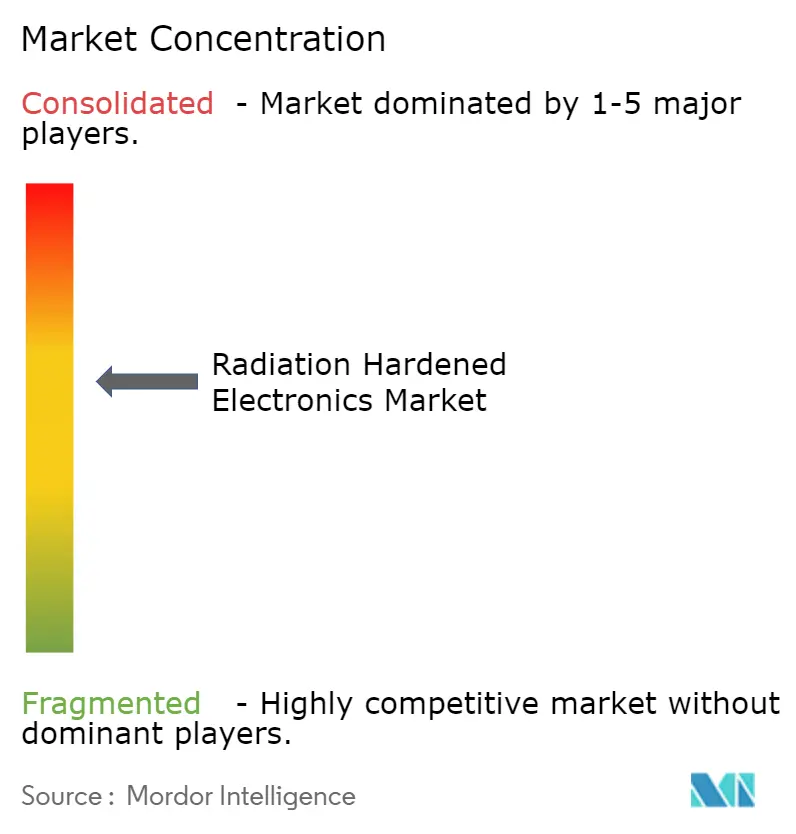
Recent Industry Developments
- May 2025: Infineon commenced 300 mm GaN pilot lines delivering 2.3× chip output per wafer, boosting rad-hard power-device availability.
- April 2025: U.S. DoD launched Commercial Leap Ahead initiatives to mature rad-hard SOI wafers and GaN HEMT devices.
- March 2025: SkyWater positioned as a trusted U.S. foundry for RH90 SOI radiation-hardened chips, aligning with Commercial Leap Ahead projects.
- February 2025: EdgeCortix SAKURA-I AI accelerator withstood heavy-ion exposure without destructive events, advancing low-power onboard inference.
- January 2025: Carnegie Mellon University unveiled a compact radiation-tolerant flip-flop architecture slated for CubeSat flight tests in 2026
Research Methodology Framework and Report Scope
Market Definitions and Key Coverage
Our study defines the radiation-hardened electronics market as new semiconductor devices and board-level modules purposely designed, processed, or firmware-shielded to survive total ionizing dose, displacement damage, and single-event effects in space, high-altitude defense assets, nuclear reactors, and medical accelerators. According to Mordor Intelligence, covered value streams span rad-hard ICs, power devices, sensors, and power-management subsystems supplied to satellite, defense, nuclear, medical, and research operators worldwide.
Scope exclusion: Discrete shielding materials, stand-alone test services, and refurbished legacy parts sit outside this scope.
Segmentation Overview
- By End-User
- Space
- Aerospace and Defense (Air, Land, Naval)
- Nuclear Power Generation and Fuel Cycle
- Medical Imaging and Radiotherapy
- High-Altitude UAV/HAPS Platforms
- Industrial Particle Accelerators and Research Labs
- By Component
- Discrete Semiconductors
- Sensors (Optical, Image, Environmental)
- Integrated Circuits (ASIC, SoC)
- Microcontrollers and Microprocessors
- Memory (SRAM, MRAM, FRAM, EEPROM)
- Field-Programmable Gate Arrays (FPGA)
- Power Management ICs
- By Product Type
- Analog and Mixed-Signal
- Digital Logic
- Power and Linear
- Processors and Controllers
- By Manufacturing Technique
- Rad-Hard-by-Design (RHBD)
- Rad-Hard-by-Process (RHBP)
- Rad-Hard-by-Software/Firmware Mitigation
- By Semiconductor Material
- Silicon
- Silicon Carbide (SiC)
- Gallium Nitride (GaN)
- Others (InP, GaAs)
- By Radiation Type
- Total Ionizing Dose (TID)
- Single-Event Effects (SEE)
- Displacement Damage Dose (DDD)
- Neutron and Proton Fluence
- By Geography
- North America
- Europe
- Asia-Pacific
- South America
- Middle East and Africa
Detailed Research Methodology and Data Validation
Primary Research
Mordor analysts interview spacecraft program managers, foundry engineers, radiation test-lab specialists, and procurement leads across North America, Europe, and Asia-Pacific. Their insights confirm dose thresholds, launch backlogs, price progressions, and adoption timing that documents alone cannot reveal.
Desk Research
We begin with open, high-quality data from NASA and ESA launch logs, US DoD budget books, IAEA reactor counts, Semiconductor Industry Association shipment series, IEEE papers, and customs trackers. Public company 10-Ks, investor decks, and reputable news accessed through Dow Jones Factiva and D&B Hoovers refine selling prices and vendor footprints. These references outline historical demand pools; many other repositories supported validation.
Market-Sizing & Forecasting
A top-down rebuild starts with satellite launches, reactor inventories, defense platform counts, and LINAC installs, then multiplies each pool by rad-hard content and refreshed average selling prices. Supplier roll-ups and targeted channel checks offer a bottom-up sense check. Key variables like launch cadence, semiconductor load per satellite, SiC/GaN yield trends, and defense modernization outlays feed a multivariate regression blended with scenario analysis through 2030; expert ranges close remaining gaps.
Data Validation & Update Cycle
Outputs pass variance screens, peer review, and anomaly checks. Models refresh annually, with interim updates after material events, and we run a fresh audit before delivery.
Why Mordor's Radiation Hardened Electronics Baseline Earns Trust
Published values often diverge because firms vary component mix, price decks, and refresh cadence. By anchoring scope strictly to rad-qualified electronics and updating variables each year, our team delivers a balanced baseline users can trace.
Benchmark comparison
| Market Size | Anonymized source | Primary gap driver |
|---|---|---|
| USD 1.88 B (2025) | Mordor Intelligence | |
| USD 1.69 B (2024) | Global Consultancy A | narrower component set; military emphasis |
| USD 1.60 B (2024) | Industry Analyst B | bundles shielding alloys; mixes currencies |
| USD 1.73 B (2024) | Trade Journal C | omits medical and research demand |
Taken together, the comparison shows our disciplined scope choice, traceable variables, and quicker refresh cadence make Mordor's numbers the dependable starting point for decision-makers.
Key Questions Answered in the Report
What is the current size of the radiation hardened electronics market and how fast is it growing?
The market stands at USD 1.88 billion in 2025 and is forecast to reach USD 2.27 billion by 2030, reflecting a 3.84% CAGR.
Which end-user segment generates the highest revenue today?
Space applications lead with 46.3% share in 2024, anchored by satellite constellations and deep-space missions that demand ultra-high radiation tolerance.
Where is the fastest regional growth expected through 2030?
Asia Pacific shows the highest projected growth at a 4.1% CAGR, driven by expanding space programs and new nuclear-power builds.
Which component category is expanding the quickest?
Field-programmable gate arrays are set to grow at a 4.6% CAGR because their in-orbit reconfigurability lets operators update payloads without physical access.
How are wide-band-gap materials influencing the market?
Gallium nitride power devices are gaining traction with a 5.7% CAGR forecast, offering higher efficiency and greater single-event resilience than traditional silicon parts.
What is the main supply-chain bottleneck facing manufacturers?
Restricted foundry capacity for RHBP nodes at or below 90 nm limits production of advanced devices and lengthens qualification timelines.
Page last updated on:



